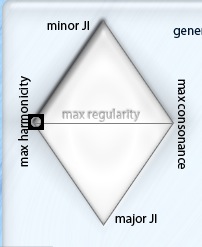

The Tone DiamondThe tone diamond offers two dimensions of control over the sound: the horizontal position defines the timbre of the sound (more precisely, the exact placement of the overtones) while the vertical axis controls the tuning of the sound (the pitch). The TransFormSynth changes both the timbre and tuning in real time as the position of the control point changes. The tuning is adjusted by changing the frequency of the fundamental, while the timbre is changed by adjusting the location of the overtones using the spectral mapping technique.
Harmonicity is a measure of how harmonic a sound is: how close the overtones of the sound are to a harmonic series. Thus, when the marker is on either of the two lines labeled "max harmonicity", the partials are mapped to integer multiples of the fundamental. The further the marker is from the max harmonicity line, the less harmonic it becomes. One way to measure consonance, called "sensory consonance" measures how well the overtones of a sound align with each other over all the intervals of interest. When the marker is on either of the two lines labeled "max consonance", the partials are mapped to the scale steps of the tuning. This tends to maximize the sensory consonance throughout the tuning. The further the marker is from the "max consonance" lines, the lower the sensory consonance of the system. The horizontal line labeled "max regularity" is where the tuning is completely defined by two generators: the (pseudo) octave and the "beta" parameter (on the large vertical slider in the tuning continuum). At the bottom of the diamond, the label "Major JI" indicates that the tuning is a (major) Just Intonation scale. By moving the control point, the tuning slides smoothly and continuously between the regular tuning and the JI. Thus it is possible to smoothly connect any of the tunings of a continuum with a nearby JI in a transparent and musically sensible way. Tunings between JI and max regularity are similar to those irregular temperaments known as "well-temperaments" or "circulating temperaments", where different keys (and different chords within the same key) have slightly different tunings. Similarly, the point at the top of the diamond represents a minor just intonation and the two dimensional continuum allows smooth motions between this JI and the various tunings of the continuum. It is impossible for a musical system to simultaneously have maximal regularity, harmonicity, and consonance. The tone diamond enables explicit compromises between these three features. For example, when the marker is placed on the dot in the center of the upper triangle, the deviations from maximal regularity, harmonicity, and consonance are shared equally, and so are each relatively small. |
©2008 William Sethares; site design by Anthony Prechtl |